Science & Technology
Elon Musk's SpaceX Starship Update Event - Livestream
SpaceX rolls Starship prototype to launch pad ahead of orbital test flight
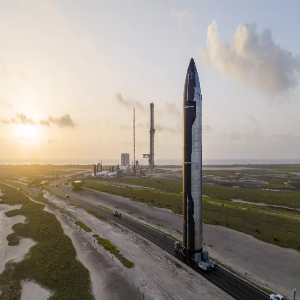
The SpaceX Starship prototype Ship 24 rolls to the launch pad at the company’s Starbase facility in South Texas. SpaceX shared this photo via Twitter on July 6, 2022. (Image credit: SpaceX via Twitter)
We may not have to wait too much longer for the first-ever orbital test flight of SpaceX’s Starship deep-space transportation system.
SpaceX is developing Starship to carry people and cargo to Mars, the moon and other far-flung destinations. The system consists of two elements, both of which are designed to be fully and rapidly reusable: a huge first-stage booster called Super Heavy and a 165-foot-tall (50 meters) upper-stage spacecraft called Starship.
Starship prototypes have conducted a handful of high-altitude test flights to date, but the vehicle has yet to go orbital. SpaceX plans to change that soon; the company is gearing up to launch an orbital test mission with the system, which will also mark the spaceflight debut of Super Heavy.
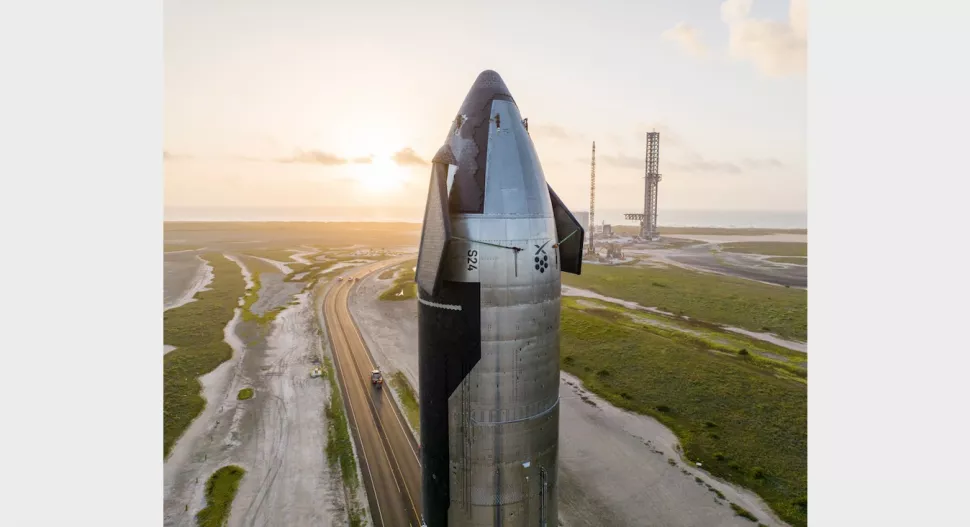
Another shot of Ship 24 on the move toward the launch pad at SpaceX’s Starbase facility, posted on Twitter by the company on July 6, 2022. (Image credit: SpaceX via Twitter)
And those preparations are ramping up. Ship 24, the Starship vehicle that will fly the orbital mission, just rolled out to the launch pad at Starbase, SpaceX’s South Texas facility, company representatives announced via Twitter today(opens in new tab) (July 6). In that same post, SpaceX shared three photos of the big spacecraft on the move.
Ship 24 will launch atop a Super Heavy known as Booster 7. That rocket is already at the pad and may conduct a static fire test — a prelaunch trial in which a rocket’s engines are lit while the vehicle stays anchored to the ground — in the coming days.
Both Starship and Super Heavy are powered by SpaceX’s next-generation Raptor engine. The spacecraft sports six Raptors, and the booster features a whopping 33, as SpaceX showed in another recent Twitter post(opens in new tab) that shared photos of both vehicles with all of their engines installed.
For comparison, SpaceX’s workhorse Falcon 9 rocket incorporates nine of the company’s Merlin engines in its first stage and one Merlin in its upper stage. And Merlins are considerably smaller and less powerful than Raptors.

This image, which SpaceX posted on Twitter on July 6, 2022, shows Ship 24 on the move toward the launch pad with the Super Heavy known as Booster 7 in the foreground. (Image credit: SpaceX via Twitter)
SpaceX recently cleared a significant regulatory hurdle on the road to Starship’s first orbital launch: Last month, the U.S. Federal Aviation Administration (FAA) announced that SpaceX could continue its Starship work at Starbase, provided the company takes more than 75 actions to mitigate the effects of that work on the surrounding area, which is a biodiversity hotspot.
There are other such boxes to check, however; for example, the FAA must still grant SpaceX a launch license ahead of the upcoming orbital attempt.
Mike Wall is the author of “Out There(opens in new tab)” (Grand Central Publishing, 2018; illustrated by Karl Tate), a book about the search for alien life. Follow him on Twitter @michaeldwall(opens in new tab). Follow us on Twitter @Spacedotcom(opens in new tab) or on Facebook(opens in new tab).
Join our Space Forums to keep talking space on the latest missions, night sky and more! And if you have a news tip, correction or comment, let us know at: community@space.com.
SpaceX installs 29 engines on giant Super Heavy Mars rocket (photos)
The company is gearing up for the first orbital test flight of its Starship system.
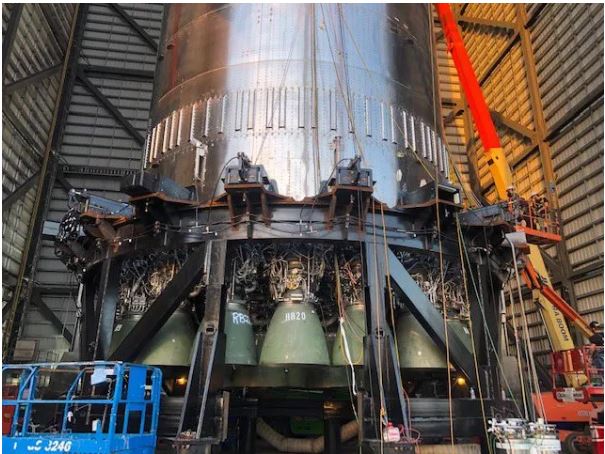
Elon Musk posted this photo of a SpaceX Super Heavy booster prototype, with its newly installed Raptor engines, on Twitter on Aug. 2, 2021. (Image credit: Elon Musk via Twitter)
Starship is powering up.
SpaceX plans to launch the first orbital test flight of Starship, its reusable deep-space transportation system, in the next few months from the company’s South Texas site, near the Gulf Coast village of Boca Chica.
The company has made significant strides toward that milestone in the past few days, getting Starship’s giant first-stage booster, known as Super Heavy, ready to fly.
“Installing Starship booster engines for first orbital flight,” SpaceX founder and CEO Elon Musk said via Twitter yesterday (Aug. 1) in a post that included a photo of the rocket, with himself holding his young son nearby. And today (Aug. 2), Musk tweeted a close-up photo of Super Heavy’s base, which is now bristling with Raptor engines.
Related: SpaceX’s Starship and Super Heavy rocket in pictures
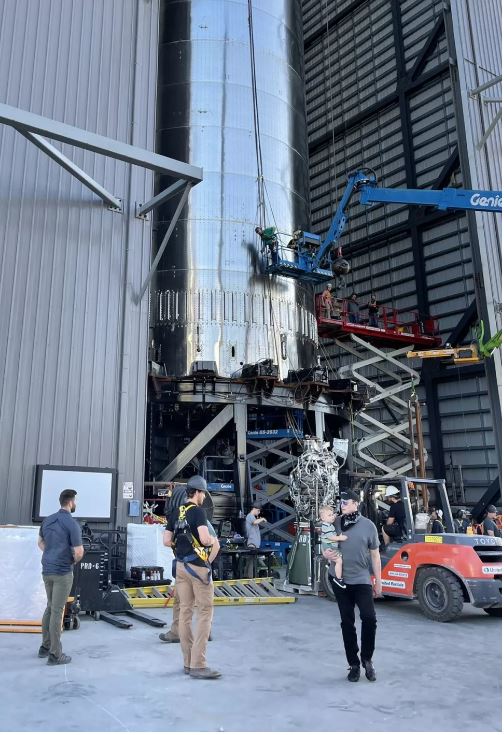
“Installing Starship booster engines for first orbital flight,” SpaceX founder and CEO Elon Musk wrote about this photo, which he posted on Twitter on Aug. 1, 2021. (Image credit: Elon Musk via Twitter)
Super Heavy will initially sport 29 Raptors, and future versions will have 32 of the engines, Musk has said. Starship’s upper stage, a 165-foot-tall (50 meters) spacecraft called Starship, will be powered by six additional Raptors.
Three-engine Starship prototypes have flown multiple times, on test flights that reached a maximum altitude of 6.2 miles (10 kilometers). In May, a vehicle known as SN15 (“Serial No. 15”) became the first to ace this high-altitude hop, surviving its touchdown intact. (Several of SN15’s predecessors did well until the very end, failing to stick the landing.)
SN15’s success cleared the way for the coming orbital flight, which will be the first liftoff of a Super Heavy vehicle. A fully stacked Starship, consisting of a Super Heavy known as Booster 4 and the SN20 upper-stage prototype, will launch from South Texas.
Shortly after liftoff, Booster 4 will splash down in the Gulf of Mexico. Meanwhile, SN20 will power itself to orbit, making a splashdown of its own in the Pacific Ocean near the Hawaiian island of Kauai, about 90 minutes after launch.
SpaceX hopes to launch this uncrewed test flight before the end of the year. However, the company will have to overcome logistical as well as technical hurdles to make that happen. For example, the U.S. Federal Aviation Administration is conducting an environmental review of Starship’s launch operations, and it’s unclear when that will conclude.
Mike Wall is the author of “Out There” (Grand Central Publishing, 2018; illustrated by Karl Tate), a book about the search for alien life. Follow him on Twitter @michaeldwall. Follow us on Twitter @Spacedotcom or Facebook.
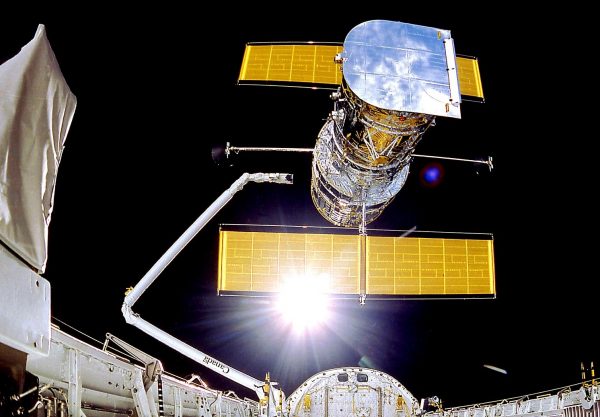
The NASA/ESA Hubble Space Telescope during deployment in 1990.
NASA’s beloved Hubble Space Telescope has been facing one of its greatest challenges. A technical glitch left it in safe mode for over a month. This week, NASA said it finally tracked down the source of the issue and tried a new fix, and it seems to have worked.
“NASA has successfully switched to backup hardware on the Hubble Space Telescope, including powering on the backup payload computer, on July 15,” the space agency announced on Friday.
The telescope has been in service for over 30 years. The Hubble team had been looking at the payload computer — hardware dating back to the 1980s — as the potential source of a memory problem. “A series of multi-day tests, which included attempts to restart and reconfigure the computer and the backup computer, were not successful, but the information gathered from those activities has led the Hubble team to determine that the possible cause of the problem is in the Power Control Unit,” NASA said.
As with the payload computer, the PCU is part of Hubble’s Science Instrument Command and Data Handling unit. The PCU is responsible for supplying a constant and steady source of electricity to the computer and its memory. Hubble is equipped with a lot of backup systems, including a spare PCU.
Since the issue cropped up on June 13, Hubble’s science work has been stalled. The switch to backup hardware should give the telescope a new lease on life. “The Hubble team is now monitoring the hardware to ensure that everything is working properly,” said NASA. It will take over a day to get the science instruments out of safe mode before normal science operations can resume.
NASA operates Hubble in partnership with the European Space Agency. “We’re extremely happy to announce that Hubble is back online!” ESA’s Hubble team tweeted on Friday. “Congratulations to the entire team that worked around the clock to make this happen.”
We're extremely happy to announce that Hubble is back online! Congratulations to the entire team that worked around the clock to make this happen. A big thank you goes to the NASA GSFC/STScI engineering & science team. Next up: resuming scientific observations #WelcomeBackHubble https://t.co/t8SMzk0ZAH
— HUBBLE (@HUBBLE_space) July 16, 2021
There has been concern for the aging telescope. Its successor, the much-delayed James Webb Space Telescope, is still here on Earth, waiting for a possible late-2021 launch.
Hubble has weathered many technical glitches in its time, and it’s looking like the venerable telescope will persevere through this latest one. Hold on, universe, Hubble is coming back.
Follow CNET’s 2021 Space Calendar to stay up to date with all the latest space news this year. You can even add it to your own Google Calendar.
China Successfully Land Rover On Mars

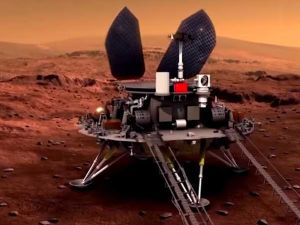
China’s space agency said Friday the country’s first Mars rover safely touched down and began sending data back to Earth, joining the United States as the only two nations to successfully land and operate a spacecraft on the surface of the Red Planet.
The Zhurong rover successfully descended to the Martian surface aboard a landing platform after a scorching re-entry from a speed of nearly 11,000 mph (about 4.8 kilometers per second).
Landing occurred at 7:18 p.m. EDT (2318 GMT) Friday, according to the China National Space Administration.
China’s Tianwen 1 orbiter released the module containing the rover about three hours before landing, sending the capsule on a trajectory to dive into the Martian atmosphere about 77 miles (125 kilometers) above the planet. The entry capsule, protected by a thermal barrier, initially slowed to about 1,000 mph (460 meters per second) from the friction from Martian air molecules.
Following a landing profile similar to NASA’s Mars missions, the spacecraft deployed a supersonic parachute to continue slowing the lander’s velocity, Chine state media reported. The craft then jettisoned its parachute and heat shield, and used a retro-propulsion system to do the rest of the braking before touchdown on an expansive flat plain named Utopia Planitia in the northern hemisphere.
Chinese state media described the nine-minute entry, descent, and landing as the riskiest part of the Tianwen 1 mission — China’s first interplanetary explorer. Tianwen 1, consisting of an orbiter, lander, and rover, launched from Earth last July on China’s heavy-lift Long March 5 rocket.
“Each step had only one chance, and the actions were closely linked,” said Geng Yan, an official at the Lunar Exploration and Space Program Center of the CNSA, in a report published by China’s state-run Xinhua news agency. “If there had been any flaw, the landing would have failed.”
Tiawen 1 became the first Chinese mission to enter orbit around Mars when it arrived in February, making China the sixth country or space agency to have a probe orbiting the Red Planet, following the United States, the former Soviet Union, the European Space Agency, India, and the United Arab Emirates.
China jointed an even smaller international club with the Mars landing Friday. Only two nations previously achieved a soft landing on the Red Planet.
The Soviet Union’s Mars 3 lander was the first spacecraft to perform a soft landing on the Martian surface in December 1971, but the probe stopped transmitting about two minutes later.
Nine U.S. missions have successfully landed on Mars since 1976.
In a post on Chinese social media, CNSA said the Zhurong rover started sending telemetry back to Earth after landing on Mars, confirming the robot was alive after touchdown. It was not immediately clear when the first images from Zhurong will come back to Earth.
China did not announce the exact schedule for the landing attempt Friday, and there was no live television coverage of the event.
Thomas Zurbuchen, head of NASA’s science mission directorate, congratulated China on the landing of Zhurong rover.
“Congratulations to CNSA’s Tianwen 1 team for the successful landing of China’s first Mars exploration rover, Zhurong!” Zurbuchen tweeted. “Together with the global science community, I look forward to the important contributions this mission will make to humanity’s understanding of the Red Planet.”
If all goes according to plan, a 529-pound (240-kilogram) Zhurong rover will exit the landing platform down a ramp to begin driving around the unexplored landing site.
In an interview on Chinese state television, Wu Yanhua, CNSA’s vice administrator, said the Zhurong rover will depart its landing platform May 22. The lander and rover will take photos of each other May 27, Wu said.
Tianwen 1 arrived at Mars one day after the UAE’s Hope orbiter steered into orbit around the Red Planet, and eight days before landing of NASA’s Perseverance rover. The favorable planetary alignment of Earth and Mars that allowed the three missions to reach Mars in February comes once every 26 months.
Since arriving at Mars in February, the Tianwen 1 spacecraft maneuvered into an orbit closer to the planet to set up for deployment of the capsule containing the Zhurong rover.
Chinese officials announced the Zhurong as the name of the rover last month, naming the craft after the god of fire in ancient Chinese mythology.
The name Tianwen comes from the title of a poem written by the ancient Chinese poet Qu Yuan. Tianwen translates to Questions to Heaven.
The Tianwen 1 orbiter adjusted the low point of its elongated orbit to reach a collision course with Mars in the hours before the rover’s landing, according to amateur radio enthusiasts who track the trajectories of interplanetary space probes. Once ground teams confirm the orbiter is on a good trajectory, the carrier deployed the entry module and fired thrusters to re-establish a stable orbit around Mars.
Most Mars landers enter the Martian atmosphere on a direct course from Earth. Those trajectories typically have preset landing dates tied to when the missions launched. The design of the Tianwen 1 mission gave Chinese officials flexibility on when to schedule the landing.
The Tianwen 1 orbiter, which will continue its mission after releasing the lander and rover, is designed to operate for at least one Martian year, or about two years on Earth. The solar-powered rover, standing about 5.9 feet (1.8 meters) tall, has a life expectancy of at least 90 days, Chinese officials said.
In addition to mapping and survey duties, the orbiter will relay communications signals between ground controllers in China and the rover exploring the Martian surface.
With a successful landing accomplished, the rover will activate cameras, a subsurface radar to probe underground water ice, sensors to measure the composition of Martian rocks, a magnetic field monitor, and a weather station to begin collecting data at the Utopia Planitia location.
The Zhurong rover has six wheels, and sizes up slightly larger than NASA’s defunct Spirit and Opportunity rovers, which landed on the Red Planet in 2004. The Chinese craft is significantly smaller than NASA’s Curiosity and Perseverance rovers.
Wang Chi, director of the National Space Science Center at the Chinese Academy of Sciences, said in March that China is “open to international cooperation” and said data from the Tianwen 1 mission will be “available publicly soon.”
Scientists from the Institut de Recherche en Astrophysique et Planétologie, or IRAP, in France contributed to a Laser-Induced Breakdown Spectroscopy instrument on the Tianwen 1 rover.
French scientists, with support from the French space agency CNES, provided guidance to their Chinese counterparts on the spectroscopy technique, which uses a laser to zap a pinhead-size portion of a rock, and a spectrometer to analyze the light given off by plasma generated by the laser’s interaction with the rock’s surface.
The advanced technique allows an instrument to determine the chemical make-up of rocks on Mars. French scientists also provided China with a calibration target for the rover’s laser spectroscopy instrument.
The same French team worked on instruments on NASA’s Curiosity and Perseverance Mars rovers. The scientists hope to cross-calibrate measurements between the two U.S.-led missions and China’s Tianwen 1 rover.
Scientists from the Space Research Institute at the Austrian Academy of Sciences assisted in the development of the magnetometer on the Tianwen 1 orbiter and helped calibrate the flight instrument.
Argentina is home to a Chinese-owned deep space tracking antenna used to communicate with Tianwen 1. The European Space Agency also agreed to provide communications time for Tianwen 1 through its own worldwide network of deep space tracking stations.
Cooperation between NASA and China is restricted by a law that bars the U.S. space agency from nearly all bilateral engagement with the Chinese space program.
Jeff Bezos' Blue Origin about to reveal when it's selling tickets to space

After a series of test flights, Blue Origin says, its rockets are nearly ready to bring passengers to the edge of space.
Blue Origin, the rocket startup from Amazon founder Jeff Bezos, on Tuesday will reveal details about how and when to purchase tickets to ride its New Shepard rocket into space. The space tourism rocket has completed a series of test flights and landings, recently completing a test with people inside during launch preparation and a dummy inside during the flight itself.
New Shepard is designed to bring as many as six passengers to an altitude of 66 miles above Earth’s surface.
Blue Origins hasn’t revealed when tickets will be available or what they will cost, but the front page of its website now shows a countdown to the May 5 announcement.
“Sign up to learn how you can buy the very first seat on New Shepard,” the website reads.
Mastcam-Z Video of Ingenuity Take Off & Landing on Mars
NASA’s Ingenuity Mars Helicopter takes off and lands in this video captured on April 19, 2021, by Mastcam-Z, an imager aboard NASA’s Perseverance Mars rover. This video features only the moments of takeoff and landing. As expected, the helicopter flew out of its field of vision but the shadow of it hovering is visible The Ingenuity Mars Helicopter was built by JPL, which also manages this technology demonstration project for NASA Headquarters. It is supported by NASA’s Science Mission Directorate, Aeronautics Research Mission Directorate, and Space Technology Mission Directorate. NASA’s Ames Research Center and Langley Research Center provided significant flight performance analysis and technical assistance during Ingenuity’s development. A key objective for Perseverance’s mission on Mars is astrobiology, including the search for signs of ancient microbial life. The rover will characterize the planet’s geology and past climate, pave the way for human exploration of the Red Planet, and be the first mission to collect and cache Martian rock and regolith (broken rock and dust). Subsequent NASA missions, in cooperation with ESA (European Space Agency), would send spacecraft to Mars to collect these sealed samples from the surface and return them to Earth for in-depth analysis. The Mars 2020 Perseverance mission is part of NASA’s Moon to Mars exploration approach, which includes Artemis missions to the Moon that will help prepare for human exploration of the Red Planet. JPL, which is managed for NASA by Caltech in Pasadena, California, built and manages operations of the Perseverance rover.
Huge Change to Humanities.....Elon Musk Neuralink chip tested live in pig and monkey's brains.
Elon Musk's Neuralink shows monkey with brain-chip playing videogame by thinking

(Reuters) – Billionaire entrepreneur Elon Musk’s brain-chip startup released footage on Friday appearing to show a monkey playing a simple videogame after getting implants of the new technology.
The 3-minute video by Neuralink here shows Pager, a male macaque with chips embedded on each side of its brain, playing ‘Mind Pong’. Although he was trained to move a joystick, it is now unplugged. He controls the paddle simply by thinking about moving his hand up or down.
“First @Neuralink product will enable someone with paralysis to use a smartphone with their mind faster than someone using thumbs,” Musk tweeted here on Thursday.
“Later versions will be able to shunt signals from Neuralinks in brain to Neuralinks in body motor/sensory neuron clusters, thus enabling, for example, paraplegics to walk again. The device is implanted flush with skull & charges wirelessly, so you look & feel totally normal.”
Neuralink works by recording and decoding electrical signals from the brain using more than 2,000 electrodes implanted in regions of the monkey’s motor cortex that coordinate hand and arm movements, the video’s voiceover said.

“Using these data, we calibrate the decoder by mathematically modeling the relationship between patterns of neural activity and the different joystick movements they produce.”
Co-founded by Musk in 2016, San Francisco-based Neuralink aims to implant wireless brain computer chips to help cure neurological conditions like Alzheimer’s, dementia and spinal cord injuries and fuse humankind with artificial intelligence.
In August 2020, Musk unveiled a pig with a Neuralink chip implant, describing it as “a Fitbit in your skull.”
Musk has a history of bringing together diverse experts to develop technology previously limited to academic labs, including for rockets and electrical vehicles, through companies such as Tesla Inc and SpaceX.




